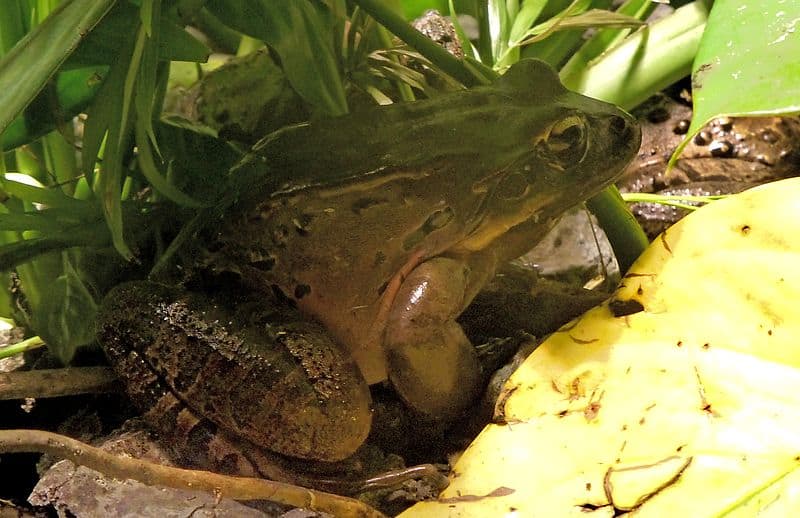Mountain Chicken Facts
- This remarkable amphibian bears the deceptive common name of the Mountain Chicken. Among researchers, however, it goes by the cumbersome scientific name of the Leptodactylus fallax. By either name, though, it’s a fascinating species.
- Quite obviously, it’s not a chicken, but the name derives from reports that its flesh tastes like that bird. Unfortunately for it, though, the creature remains a local delicacy within its endemic range. Partly due to this, its numbers have plummeted sharply.
- Concerted efforts to preserve the species do exist, however. This primarily consists of captive breeding projects, with several institutions participating. A few specimens from these projects have been introduced to their native region.
- Regrettably, though, its existence as a species continues to be threatened by several factors. For the moment, its greatest threat comes from the presence of a deadly chytridiomycosis fungus. Habitat loss also poses a great danger.
- The ongoing effects of climate change, however, may also soon endanger the Mountain Chicken. Given all these factors, the IUCN presently lists the amphibian as Critically Endangered. This status appears on its Red List of Threatened Species.
Related Articles
Mountain Chicken Physical Description
Along with its somewhat distinctive name, the Mountain Chicken stands out from its many relatives for another reason. That status occurs due to the sheer size of the amphibian. In point of fact, this impressive animal ranks as one of the largest of all known frogs.
It also, much like many amphibians, displays a moderate degree of the physiological characteristic of sexual dimorphism. In its particular case, this trait manifests itself in terms of physical size. This tendency further mimics that of a large percentage of frog species.
Males of the amazing Mountain Chicken typically reach a slightly smaller size than their female counterparts. Exceptional individuals, usually females, attain lengths of as much as 8.7 in (22 cm). These also weigh as much as an incredible 2.2 lb (1 kg).
Most specimens, however, reach slightly smaller, though still quite surprising, sizes. A more typical adult size, in fact, equals between 6.7 – 7.1 in (17 – 18 cm). That nonetheless still qualifies this marvel of Nature as an exceptionally large variety of frog.
Its coloring also develops extremely variable since it seems Nature loves variety. Consequently, individuals may be numerous colors. These include brown, barred, or spotted on the upper body. The sides and lower body typically show a shade of orange yellow.
The body of this fascinating animal further develops as relatively robust and strongly muscled for its kind. Perhaps most noteworthy of all is the presence of a large spur on each of the male’s thumbs. These the creature evolved to grasp the female during mating.
- Kingdom: Animalia
- Phylum: Chordata
- Class: Amphibia
- Order: Anura
- Family: Leptodactylidae
- Genus: Leptodactylus
- Species: L. fallax
Mountain Chicken Distribution, Habitat, and Ecology
Evidence indicates that the remarkable Mountain Chicken once existed in a somewhat broader section of the world. It appears to have evolved as native to many islands in the eastern Caribbean. Currently, however, it now appears only on Montserrat and Dominica.
While attempts have been made to reintroduce it to other islands, these have so far proven unsuccessful. This fact further puzzles researchers, since the species displays a strong flexibility in its choice of habitat, at least on the two islands its still inhabits.
There, individuals frequently inhabit a variety of habitats, provided there is a stream nearby. These include secondary forests, plantations, scrub, ravines, grasslands, and palm groves. Most individuals also prefer altitudes of no more than 1,410 ft (430 m).
The Mountain Chicken also evolved as primarily nocturnal in its patterns of activity. Mainly hunting at night, it does so as an ambush predator. It’s also well known among researchers for its voracious appetite. It happily eats virtually any prey that fits in its mouth.
Due to this indiscriminate feeding pattern, its typical prey understandably includes a wide range of victims. The majority of these, though, consist of various local insects and small crustaceans. It does, however, occasionally eat bats, snakes, and even other frogs.
Species Sharing Its Range
Check out our other articles on 7 Stunning European Flowering Plants, Thorny Dragon, Moeraki Boulders, Galapagos Penguin, Yeti Crab, Yosemite Cave Pseudoscorpion, Australian Sea Lion

